Today’s digital world is based on advancements in mathematics, computer science, data science, and artificial intelligence. Almost everything involving technology, from search engines to self-driving cars, depends on these disciplines. However, algorithms are at the core of these fields.
In the digital age, algorithms reign supreme as the backbone of modern computing. From powering search engines to guiding autonomous vehicles, algorithms dictate the fabric of our technological landscape. Understanding their fundamentals is paramount for navigating this complex terrain.
This article will focus on answering questions like: What is an algorithm? What is an example of an algorithm? and understanding their types, usage, and more.
What is an Algorithm?
An algorithm is the engine of all technological advancements. Its most basic form is a set of procedures that allows computers to perform a specific task.
They act as the digital world’s genetic makeup, dictating to machines what, how, and when to make decisions. Any set of instructions or finite rules that allows for calculations and solving problems (often mathematical) is an algorithm.
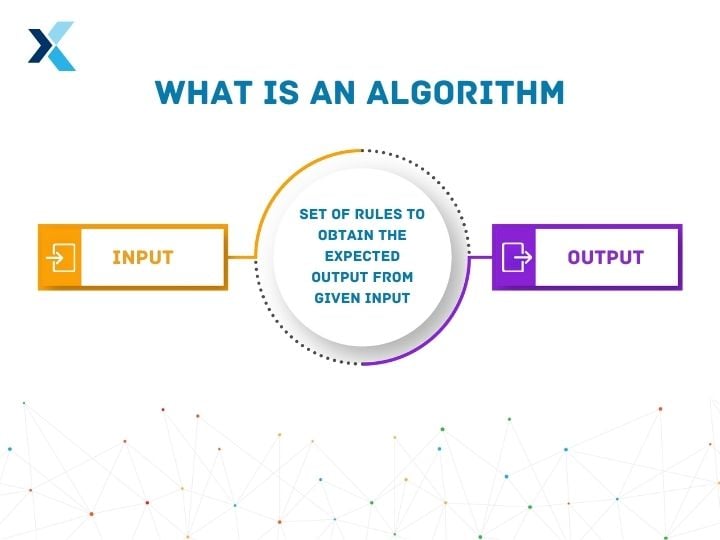
If you can now define an algorithm, then let’s answer another question: What role does an algorithm play in data science, but before that-
Explore our signature Data Science and Analytics courses that cover the most important industry-relevant tools and prepare you for real-time challenges. Enroll and take a step towards transforming your career today. We also have comprehensive and industry-relevant courses in machine learning, AI engineering, and Deep Learning. Explore our wide range of courses. P.S. Check out our upcoming batches or book a free demo with us. Also, check out our exclusive enrollment offers
Algorithms in Data Science
Algorithms play a vital role in data science. Various algorithms can provide crucial insights into raw data. The following are the stages where the algorithm plays a crucial role.-
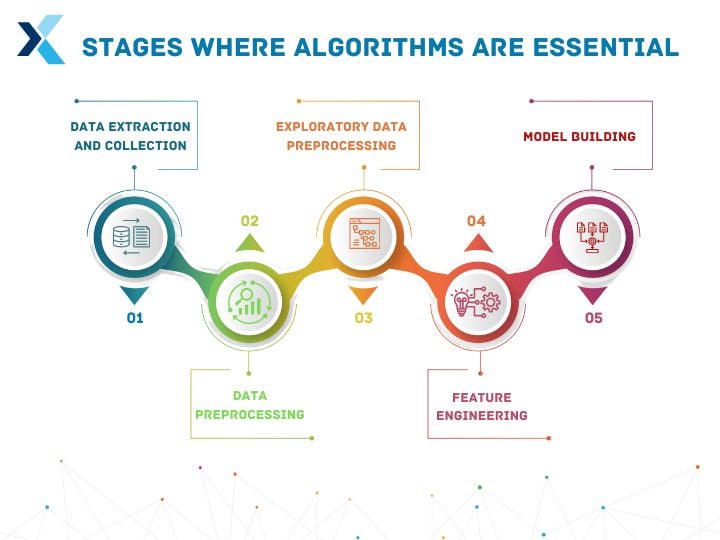
-
Data extraction and collection
Numerous web scrapping algorithms, such as DOM Parsing and Regex, are handy for extracting data.
Also read: Comprehensive Guide for Mastering Data Extraction
-
Data Preprocessing
Multiple algorithms are handy for processing data, converting unusable raw data into clean data that can be analyzed. The following are the key data preprocessing algorithms.
Missing Value Imputation
- Mean/Median/Mode Imputation
- Multiple Imputation by Chained Equations (MICE)
- K-Nearest Neighbors (KNN) Imputation
- Expectation-Maximization (EM) Algorithm
- Random Forest Imputation
- Bayesian Imputation
- Last Observation Carried Forward (LOCF)
Outlier Detection
- Interquartile Range (IQR)
- Density Based Outlier Detection (DBSCAN)
- Isolation Forest
- Robust Random Cut Forest (RRCF)
Data Normalization
- Min-Max Scaling
- Z-Score Standardization
- Box-Cox Transformation
- Yeo-Johnson Transformation
- Unit Vector Transformation
Exploratory Data Preprocessing
Some algorithms come into play to help you understand the data you are dealing with. For example, an ANOVA, a Mann-Whitney U test, etc., check whether the hypothesis about the data is correct.
Also read: Understanding Exploratory Data Analysis in Python
Feature Engineering
Algorithms help select, create, and transform features to enhance the data quality and prepare them for predictive models. Algorithms like principal component analysis (PCA), t-distributed Stochastic Neighbor Embedding (t-SNE), Linear Discriminant Analysis (LDA), SelectKBest, Lasso Regression, and Recursive Feature Elimination (RFE) help in feature selection and dimensionality reduction.
Other algorithms, like one-hot encoding and label encoding, allow categorical features to be numerical.
Model Building
Several machines and deep learning algorithms play a crucial role in data science as they allow for model building. For instance, statistical and machine learning algorithms like linear regression, logistic regression, decision trees, random forest, k nearest neighbor, support vector machines, naïve Bayes, etc., help create regression and classification models.
Other algorithms, such as k-means, DBSCAN, and Hierarchical clustering, allow for the creation of segmentation models. Several deep learning algorithms, too, play a crucial role in data science, such as Artificial Neural networks (ANN), Recurrent Neural Networks (RNN), Long short-term memory (LSTM), Convolutional Neural Networks (CNNs), Generative Adversarial Networks (GANs), and Autoencoders.
Also read: Decision Tree Algorithm in Machine Learning: Advantages
Algorithms are crucial in data science and other associated fields. We will discuss their role in the next section.
Uses of Algorithms in different disciplines
Algorithms are crucial in computer science, mathematics, operational research, and artificial intelligence. Let’s explore some of their uses in these fields.
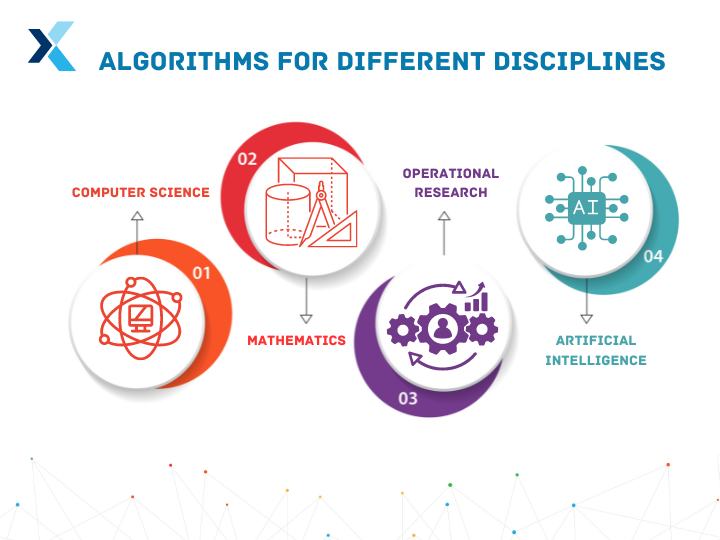
-
Computer Science
Answers to common questions, such as what an external sorting algorithm is, can be found in the field of computer science. Algorithms play a crucial role in sorting and searching related tasks.
For example, algorithms like merge sort, binary search, and quicksort help efficiently organize and retrieve data in databases, web search engines, operating systems, etc.
Dijkstra’s algorithm (to find the maximum distance from a node to all other nodes) and Prim’s algorithm (to find a minimum spanning tree for a graph) are responsible for solving problems like network routing and social network analysis.
Lastly, string matching is an important component of computer science, and algorithms like the Knuth-Morris-Pratt (KMP) algorithm, the Boyer-Moore algorithm, etc., are useful.
Also read: Computer Science vs Data Science
-
Mathematics
Numerical analysis, number theory, and various kinds of optimization are mathematics’s core aspects, and numerous algorithms are deployed. Basic algorithm examples related to optimization include Stochastic Gradient Descent (SGD), Adaptive Moment Estimation, Particle Swarm Optimization (PSO), and various Genetic Algorithms (GA) that help in solving optimization problems in economics, engineering, etc.
-
Operational research
Tasks like queuing theory, linear programming, and network flow are performed under operational research. In queue theory, algorithms are used to analyze and model systems with waiting lines (e.g., transportation systems, telecommunication networks, etc.). These algorithms include the Erlang-B formula or M/M/1 queue. Algorithms like the Ford-Fulkerson algorithm are also crucial in network flow-related tasks.
-
AI
The most prominent use of algorithms in modern society is in artificial intelligence. Algorithms like Q-learning, Deep Q-networks (DQN), Actor-Critical Methods, and Policy Gradient Methods help perform reinforcement learning-related tasks.
In natural language processing (which forms a crucial part of AI), algorithms like Naïve Bayes Classifier, SVM, RNN, and various transformer models like BERT and GPT come into play. Basic algorithm examples concerning computer vision are CNN, Fully Convolutional Networks (FCN), U-Net, and numerous transfer Learning algorithms kikes VGG and ResNet.
Also read: How to use Naive Bayes Theorem in Machine Learning [2024 edition]
Algorithms play crucial roles in several fields. However, one question remains unanswered: Why are algorithms so critical for all these fields, and why can we not eliminate them?
Why do we need algorithms?
Algorithms are essential for multiple reasons, such as
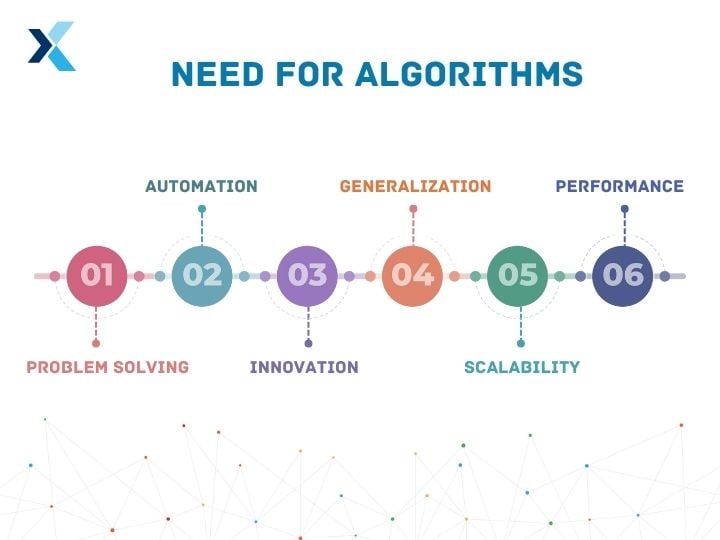
- Problem-Solving: Algorithms allow us to solve highly complex problems effectively and efficiently, which wouldn’t have been possible if we were to solve them manually.
- Automation: In comparison to manually solving problems, algorithms allow us to automate problem-solving in a much easier, quicker, and more reliable manner.
- Innovation: Through algorithms, problems that were impossible to solve earlier can now be resolved, allowing breakthroughs.
- Generalization: Algorithms can solve generic problems through optimization or predictive algorithms, allowing for the solving of problems in multiple domains such as finance, computer science, engineering, economics, etc.
- Scalability: It is possible to scale algorithms to solve sizable real-world problems.
- Performance: Large problems are divided into small solvable sub-problems through algorithms, allowing for better machine performance and resource utilization.
Let us now understand the difference between a program and an algorithm, as confusing the two is easy.
Program vs Algorithm: Major Differences
There are several differences between algorithms and programs. Let’s understand them by first going through their definitions.
An algorithm provides a set of rules and procedures to achieve a particular objective. It can be represented in multiple ways, such as flowcharts, pseudocode, natural descriptions, or the most common – mathematical notation.
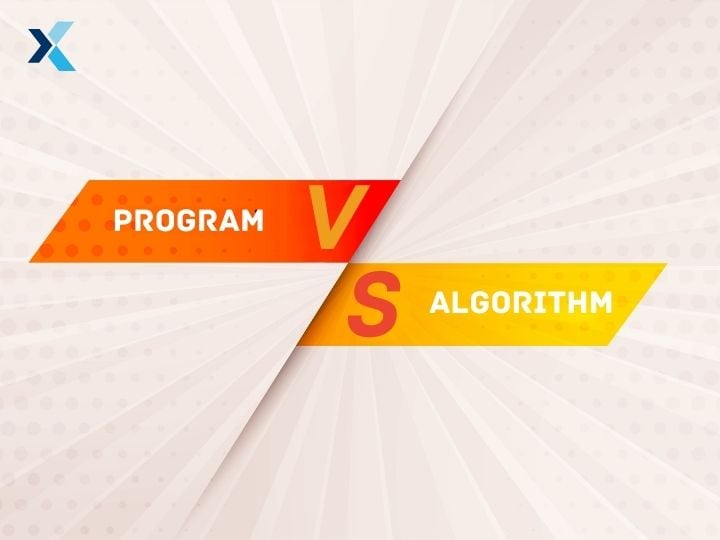
Examples of algorithms include searching algorithms (e.g., linear search, binary search), sorting algorithms (e.g., bubble sort, quicksort), optimization algorithms (e.g., gradient descent, Adam, etc.), mathematical algorithms (e.g., Euclidean algorithm, Fibonacci sequence), etc.
A program implements an algorithm where instructions are written using a programming language, which is then used to solve a problem or accomplish a task. Numerous programming constructs, like loops, functions, conditional statements, etc., are used to create programs. Software, applications, scripts, libraries, etc., are examples of programs that often implement one more algorithm.
By the definitions, it is clear that while an algorithm is a blueprint for solving an idea provided in the form of a step-by-step procedure, a program, on the other hand, is the implementation of the logic provided by the algorithm in the form of an executable code. Other key differences between the program and algorithm are as follows-
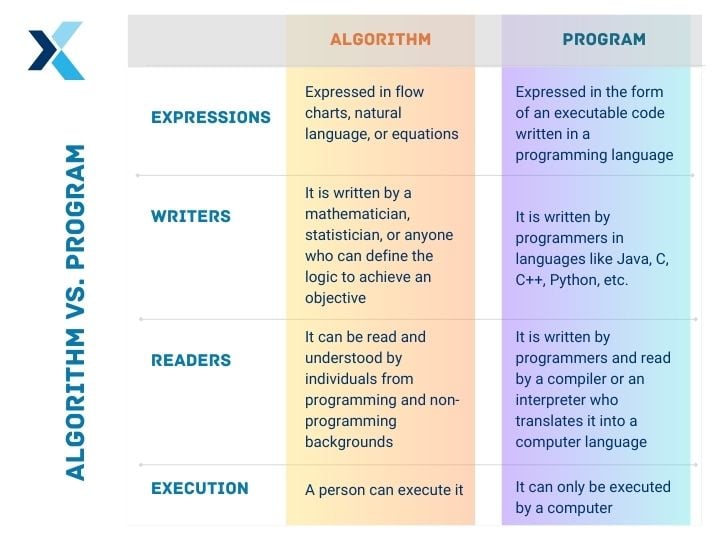
Now that you understand an algorithm and how it differs from a program, it’s time to explore its characteristics and properties.
Characteristics and Properties of an Algorithm
To properly comprehend an algorithm, one needs to understand its various characteristics and properties. If you know these characteristics and properties, you can easily answer questions like What is an example of an algorithm? as you can identify them on your own.
Characteristics of Algorithm
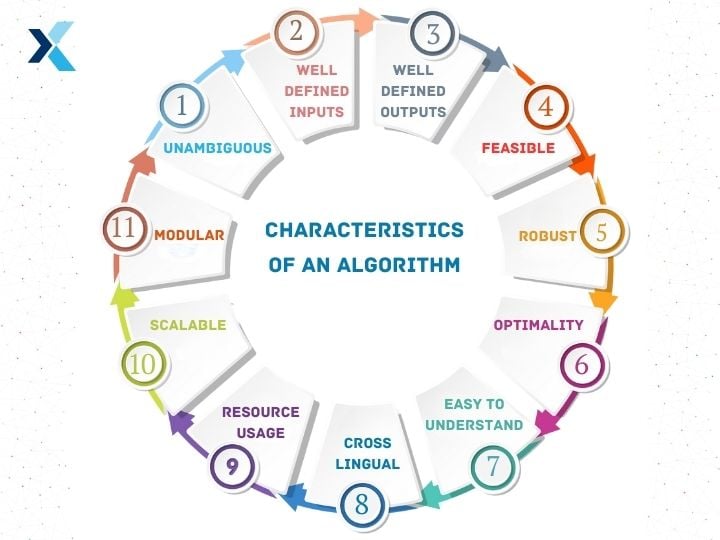
#1. Unambiguous
A key characteristic of the algorithm is that it should be precise and contain unambiguous instructions. Every step in the algorithm must be clearly defined and lead to a clear, single-defined meaning.
#2. Well-defined Inputs
Whenever an algorithm is required to take an input, it should be well-defined.
#3. Well-defined Outputs
An algorithm must have a clearly defined output that it will yield. Once the program written based on it is executed, it should return at least one output (or more if required).
#4. Feasible
Ideally, an algorithm must be generic, simple, and understandable. It should also be practical so that it can be executed given the current available resources and technology.
#5. Language Independent
An algorithm should have a set of written instructions that can be implemented in any programming language and yield the same result regardless of the language in which it is written.
#6. Optimality
An algorithm operates in several types of complexity, such as time and space complexity. A must-have property of the algorithm is that it should return the best output given certain complexity criteria.
#7. Understandable
A major characteristic of the algorithm is that it should have well-defined steps that are logical and easy to comprehend, communicate, and organize.
#8. Scalable
Given the availability of big data and complex problems that require algorithms to process large inputs, an algorithm must be scalable without compromising its performance.
#9. Resource Usage
The algorithm must be optimized so that it smartly uses computer resources like CPU, GPU, memory, etc., and ideally should consume minimal resources for its work.
#10. Robust
An algorithm must deal with various inputs, such as outliers, missing values, and other anomalies, without returning incorrect results.
#11. Modular
An algorithm must have a design that can be decomposed into reusable components that can act as sub-algorithms. The algorithm’s modular nature helps with its reusability and maintenance.
Properties of Algorithm
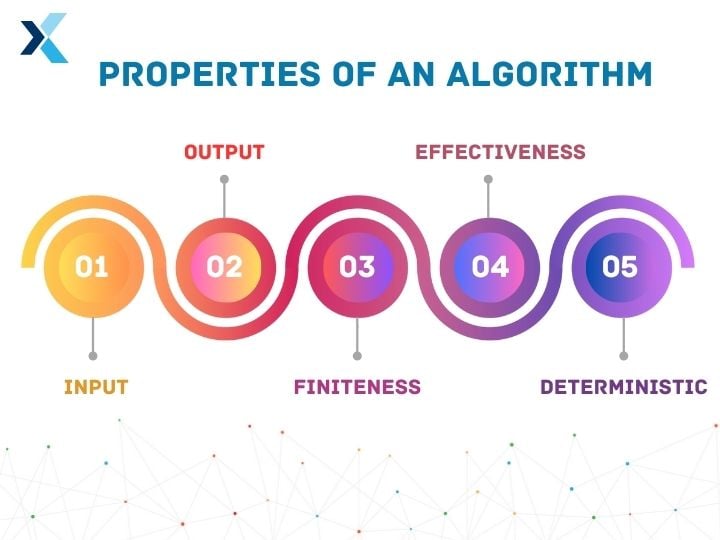
-
Input
An algorithm should be able to take zero, one, or more than one input.
-
Output
At least one output should be able to be obtained from the algorithm.
-
Finiteness
An algorithm must get terminated after following a finite time or executing a finite number of steps. Therefore, it should not run without an end or enter an infinite loop.
-
Effectiveness
The algorithm must be effective, meaning it should be able to complete its objective and return the required output by following a finite number of steps.
-
Deterministic
The user should be able to determine the algorithm’s behavior, and it should not work unexpectedly. Therefore, it should consistently produce the same result whenever the program written based on it is executed.
Now that we have covered various aspects of algorithms that help us understand them, let’s shift our focus to exploring the different categories and types of algorithms.
Classification of Algorithms
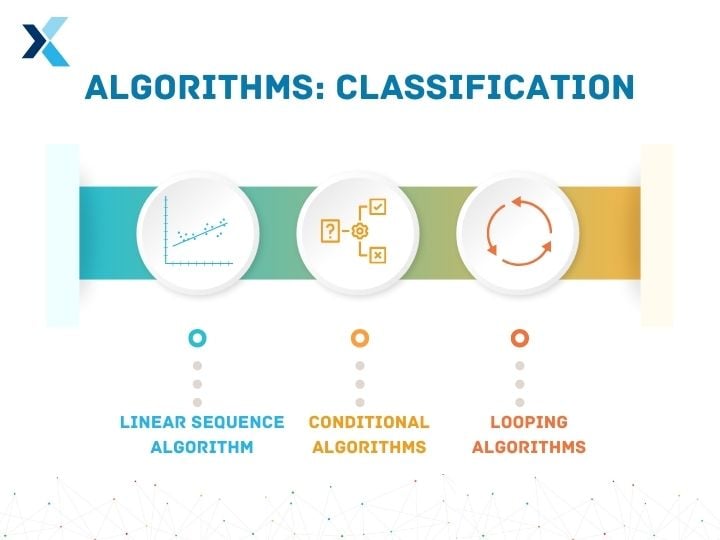
Algorithms can broadly be categorized into the following three-
-
Linear Sequence Algorithms
Such algorithms follow specific steps sequentially to reach the desired output.
-
Conditional Algorithms
Unlike linear sequence algorithms, Conditional algorithms do not execute steps one after the other but make decisions between two actions. They use the if-then statement to determine what step to execute based on the input data received by the algorithm.
-
Looping Algorithms
Looping algorithms are developed to perform repetitive tasks efficiently. In this case, the algorithm repeats instructions until a condition is met or iterations are completed.
Important Types of Algorithms
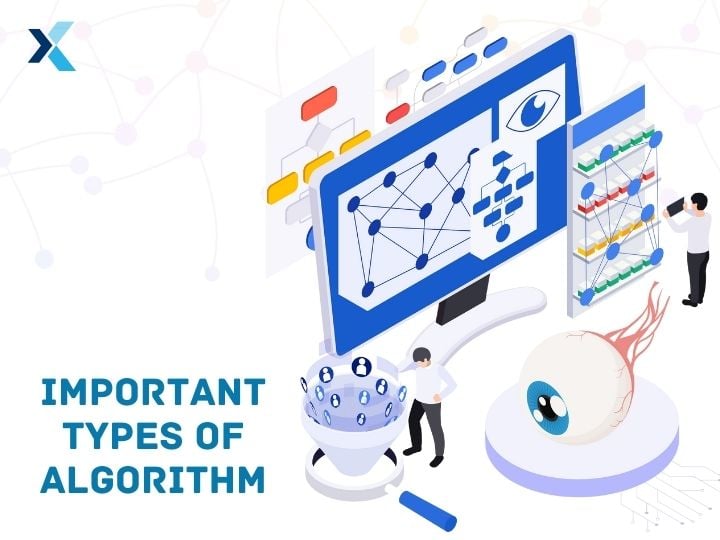
Thousands of algorithms belong to several types. A few of the most crucial types of algorithms are-
- Brute Force Algorithm
- Recursive Algorithm
- Backtracking Algorithm
- Searching Algorithm
- Sorting Algorithm
- Hashing Algorithm
- Divide and Conquer Algorithm
- Greedy Algorithm
- Dynamic Programming Algorithm
- Randomized Algorithm
- Graph Algorithm
- String Algorithm
- Numerical Algorithm
- Divide and Conquer Algorithm
- Machine Learning Algorithm
- Deep Learning Algorithm
- Cryptography Algorithm
In the next few sections, we will shift our focus from explaining algorithms and their types to answering questions like how to create an algorithm, what should be considered while designing it, etc.
How to develop Algorithmic Thinking?
Before developing an algorithm, you first need to develop algorithmic thinking. Algorithmic or computational thinking is a process and a skill that allows complex problems to be solved by breaking them into smaller and manageable chunks.
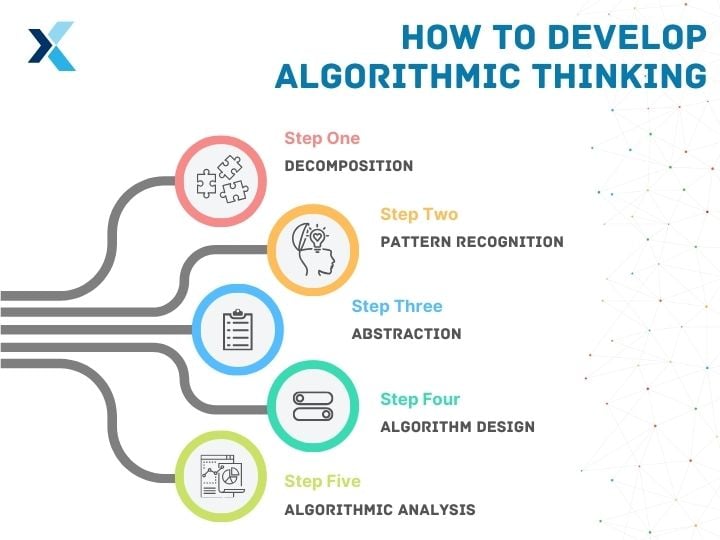
This helps increase the efficiency and replicability of the process. To answer how to create an algorithm, you must focus on algorithmic thinking that relies on the following five-step process.
-
Decomposition
Breaking problems down into smaller parts that act as manageable tasks. The constraints, required input, expected output, and dependencies of the various sub-problems are understood at this stage.
-
Pattern recognition
In the next step, how the various sub-problems interact is analyzed, which allows for understanding the similarities, differences, and connections of the different sub-problems and finding common themes, structures, data, and other resource requirements.
-
Abstraction
Abstraction is a crucial step where the most crucial information, operations, and concepts required to solve the problem are extracted, and other extraneous details are eliminated. This allows for the representation of the problem in a generalized manner.
-
Algorithm design
Each sub-problem is solved by designing logical steps. Techniques such as conditional statements, iteration, and recursion are used to explain the logic so that the solution is found efficiently, is easy to understand, and can be quickly implemented.
-
Algorithmic analysis
Lastly, the designed algorithm’s efficiency is evaluated based on complexity and performance parameters. The bottlenecks are tried to be found and eliminated, ensuring the algorithm remains efficient and returns the expected output for different inputs.
Using this process, one can design an algorithm in any field, including data science.
How to Design an Algorithm in Data Science?
Designing an algorithm is a complex process that requires a deep understanding of the problem and the desired solution. However, one can design an algorithm by following these ten crucial steps.
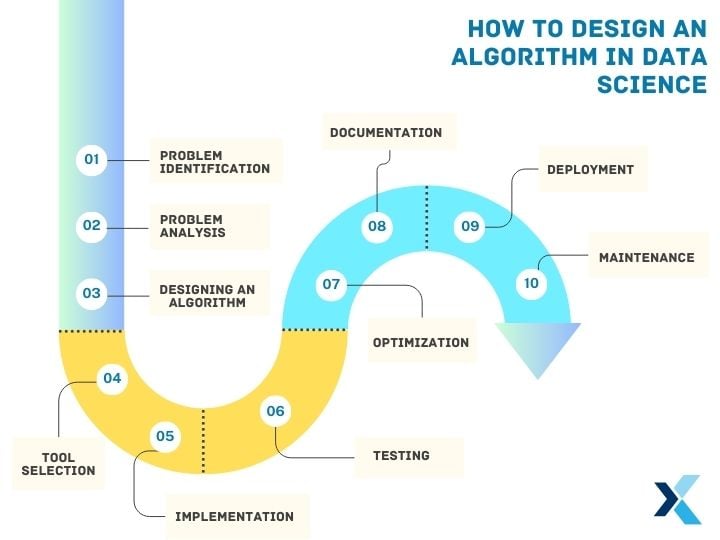
#1. Problem Identification
The first step to developing an effective algorithm is clearly stating the problem, its requirements, and other intricacies.
#2. Problem Analysis
After defining the problem, one must dive deep into it and gather all the necessary information. This is done by analyzing the data and finding patterns in it. Here, libraries like Pandas and Numpy come in handy.
#3. Designing of algorithm
Once we fully understand the problem, we will create a step-by-step process. We break down the problem into sub-problems and solve each one methodically and logically. Then, we create the high-level logic design using flow charts and tools like Microsoft Visio or Lucidchart.
#4. Tool Selection
We will identify the correct tools and technologies to employ the designed algorithm. We use IDEs like Visual Studio or PyCharm and frameworks like Scikit-learn or TensorFlow to develop the algorithm sophisticatedly.
#5. Implementation
The most crucial step is implementing the algorithm, which is done by coding the algorithm’s logic in a programming language. The choice of language can depend on the project requirement, resource availability, etc. One can typically choose from C, C++, Java, or Python.
#6. Testing
After implementing the algorithm, it is vital to ensure it works as expected; therefore, rigorous algorithm testing plays a key role. Testing tools like PyTest (for Python), JUnit (for Java), and other similar tools for different languages are to be used to ensure that the algorithm’s output is consistent.
#7. Optimization
Since hardware resources are always limited, and the input data can be huge, optimizing the algorithm’s performance is imperative. To do so, one can use tools like cProfile (for Python) to identify bottlenecks causing the algorithm to be inefficient.
#8. Documentation
Clear documentation is important as the algorithm is available to multiple individuals, sometimes at an enterprise or community level. This documentation must explain the algorithm’s different steps and functions.
This allows users to properly understand the algorithm and developers to examine its implementation and critically identify discrepancies. Doxygen and similar tools can easily generate documentation from the source code.
#9. Deployment
Platforms like Azure, GCP, or AWS facilitate the deployment of algorithms for the target audience, ensuring accessibility and scalability in the real world.
#10. Maintenance
Lastly, once we deploy the algorithm, it is important to make regular updates to ensure that it doesn’t stop working due to changes in the working conditions and requirements. Here, Git and other version control systems can manage the algorithm and its code base.
Optimization is often the most tricky part of the many steps mentioned above. In the next few sections, I explore this aspect of algorithm building and answer questions like How to analyze the efficiency of an algorithm? What is complexity of an algorithm? etc.
Stages to analyze the efficiency of an Algorithm
For any algorithm to be considered good, it must be efficient. An algorithm’s efficiency can be checked at the following stages.
-
Priori Analysis
Priori analysis refers to evaluating an algorithm’s efficiency through theoretical steps before its implementation using a programming language.
Here, the algorithm’s designer assumes factors like processing speed, input data size, traffic, etc., and estimates the program’s complexity. Such analysis does not consider the type of hardware or the compiler’s language. The algorithm’s design may be altered accordingly if any bottleneck is identified at this stage.
Also read: Apriori Algorithm In Data Mining
-
Posterior Analysis
Posterior (meaning after) analysis refers to the algorithm’s efficiency once implemented. Here, we analyze the time, space, and other computer resources the algorithm consumes to determine its exact complexity. We also attempt to eliminate bottlenecks if they are found.
To explore this topic, let’s understand how to determine an algorithm’s complexity.
Understanding algorithm complexity and steps to find it
To answer the complexity of an algorithm, you need to know that the complexity of an algorithm is dependent on two factors- space and time. Let’s explore both these factors.
-
Space Complexity
Space refers to the memory and other computer resources required to store data (input, output, and other temporary data). Here, the algorithm’s maximum memory consumption during execution is considered. The space complexity has two components.
Fixed Part
The algorithm requires space for its fixed parts, such as program size, input and output variables, etc.
Variable Part
Space dependent on the algorithm’s implementation, such as dynamic memory allocation, temporary variables, recursion stack space, etc
Thus, the Space Complexity S(P) of an algorithm P is
S(P) = C + SP(I)
where,
C: the fixed part
S(I): the variable part (dependent on instance characteristic I)
-
Time Complexity
Time complexity refers to the time it takes to execute an algorithm and get the expected results. The number of key operations is counted for this. It, too, has two components.
Constant Time Part
The time taken to execute an instruction must be executed only once, such as if-else, arithmetic operations, the input, output, etc.
Variable Time Part
The time taken to execute an instruction that is executed more than once, such as recursion, loops, etc.
Thus, the Time Complexity T(P) of an algorithm P is
T(P) = C + TP(I)
where,
C: the constant time part
TP(I): the variable time part (dependent on the instance characteristic I)
Therefore, all these aspects must be considered when designing and deploying an algorithm. You should also be aware of the algorithm’s key disadvantages and advantages so that you make the right decisions when implementing it.
Advantages and Disadvantages of Algorithms
This section will discuss an algorithm’s key disadvantages and advantages. As with any concept, algorithms have pros and cons.
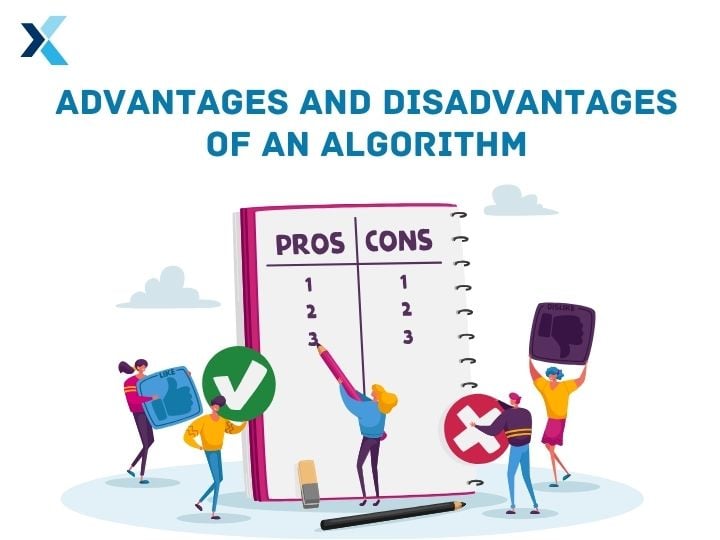
Some of the key ones are as follows-
Advantages
- Easy to understand.
- Provide a logical step-by-step representation to solve a problem.
- An algorithm can be reused for various applications, leading to efficiency.
- Automation is possible through algorithms, often making processes faster and more reliable.
- Breaking a complex problem into smaller, manageable parts allows the programmer to execute the solution using a programming language.
Disadvantages
- Writing an algorithm can be time-consuming.
- It isn’t easy to comprehend complex logic through algorithms.
- Improperly designed algorithms can consume significant computational resources.
- Communicating branching and looping statements through algorithms can be challenging.
- Biased algorithms may produce discriminatory outputs towards specific groups of individuals.
Algorithms are used across domains due to their major advantages. Let’s explore the various industries and application areas where we use algorithms prominently.
Industrial Applications of Algorithms
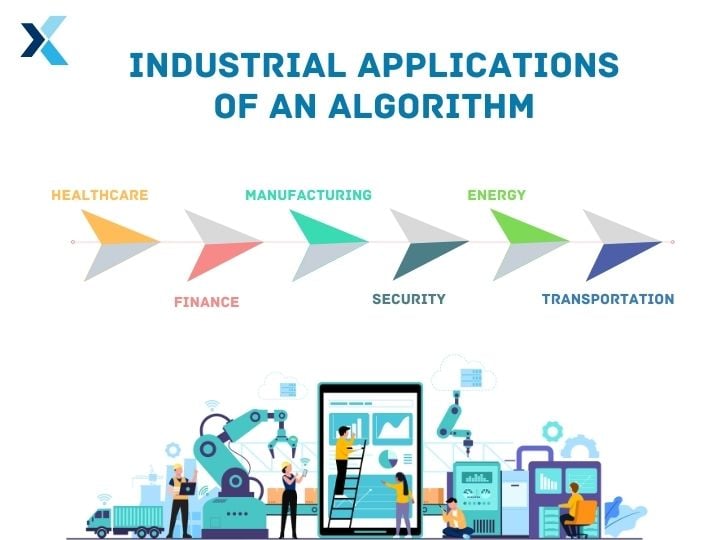
Numerous industries have created algorithms to solve their industry-specific problems. A few of the key industries where algorithms are used are as follows-
-
Healthcare
Computer vision algorithms are used in th healthcare sector for medical imaging. On the other hand, machine learning algorithms help predict diseases or side effects of new drugs and recommend personalized treatment.
-
Finance
Algorithmic trading utilizes finance algorithms to make automated trading decisions. Additionally, various machine-learning algorithms are employed to detect fraud and anomalies in insurance claims, credit card transactions, and other financial activities.
-
Manufacturing
Algorithms manage logistics, inventory, distribution networks, etc., reducing manufacturing firms’ costs and time. They also play a crucial part in analyzing machine sensory data and predicting potential failures, helping them maintain and reduce downtime.
-
Security
Algorithms analyze video streams to perform video surveillance and use several computer vision algorithms to identify suspicious activities and wanted criminals.
-
Energy
Predictive algorithms help find new energy sources, such as oil sources. Optimization algorithms also play a crucial role as they help increase efficiency and reduce carbon emissions by optimizing energy generation, distribution, and consumption.
-
Transportation
Algorithms are responsible for self-driving cars, drones, and other vehicles. They also play a key role in traffic management, using data from cameras, GPS devices, and other devices to monitor and predict traffic and find ways to decongest the roads.
Applications of Algorithm in daily life
You encounter algorithms often in your day-to-day life. Some of the most common application areas of algorithms are as follows.
-
Social media algorithms
Algorithms create personalized feeds on social media platforms like Facebook, Instagram, TikTok, etc.
-
eCommerce recommendations
Proprietary algorithms recommend new or related products on e-commerce websites like Amazon and Flipkart.
-
Search engines
One of the earliest uses of complex algorithms is in search engines. Companies like Google, Yahoo, and Microsoft (Bing) use algorithms to retrieve relevant results and websites based on user-provided keywords.
-
Navigation and ride-sharing apps
The most common use of algorithms today is with ride-sharing apps like Uber, Ola, Lyft, etc., where algorithms find cabs, optimize routes, calculate fares, and more.
The widespread adoption and use of algorithms have revolutionized the world; however, they have also raised some eyebrows for ethical reasons, which we will discuss ahead-
Ethics in algorithmic decision-making
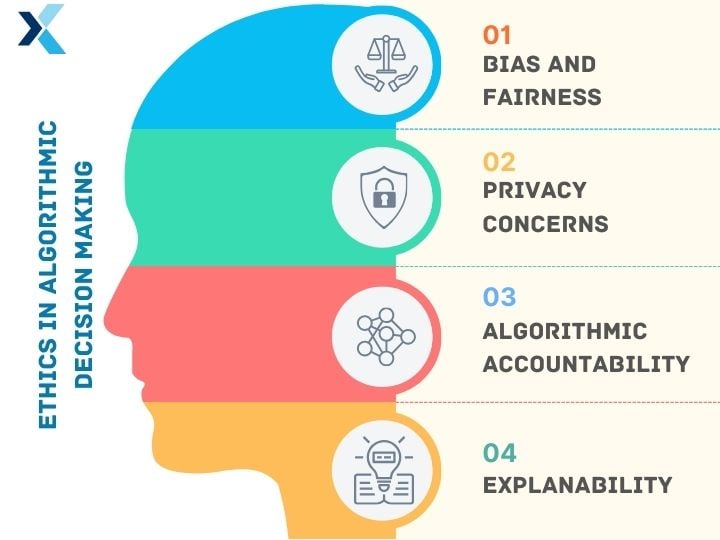
Algorithms need to be deployed in responsible and ethical ways, and by not doing so, several problems can emerge, such as
-
Bias and fairness
Algorithms are trained on datasets, and biases can be perpetuated if the information in the datasets is skewed or if the algorithm is not properly trained. This, in turn, causes the algorithm to produce biased outputs against a particular group due to their race, gender, nationality, etc. Such biased algorithms can cause havoc in fields like job hiring, criminal justice, or money lending.
-
Privacy concerns
Algorithms often need to access large amounts of personalized data, which can raise concerns about surveillance, data protection, and more. Thus, there should be transparency regarding data usage.
-
Algorithmic accountability
Mechanisms are to be put in place so that algorithm developers stay responsible. Currently, it is possible that the algorithm’s stakeholders are not held accountable in case it malfunctions.
-
Explainability
Algorithms are often based on complex mathematical concepts. This is especially true for machine and deep learning algorithms. Their problem is that it’s difficult to understand how they reach a particular decision, causing a lack of interpretability. Thus, algorithmic explainability needs to increase.
Conclusion
Algorithms are the engine that drives the digital world around us. They are responsible for recommending videos on YouTube to drive self-driving cars. Any data scientist must know about algorithms, especially machine learning algorithms, as this allows them to develop better models.
Data scientists need to be aware of multiple categories and types of algorithms so that they can implement them correctly and develop new ones.
FAQS
- What is an example of an algorithm?
Binary search is an example of an algorithm used to find a particular value in a sorted array.
- What are the types of algorithms?
Algorithms have many categories like, linear sequence, conditional, and looping algorithms and can have many types, such as search, sorting, graph, greedy algorithm, etc.
- What is an algorithm in programming for beginners?
An algorithm is a set of logical steps and procedures that allow users to achieve a particular objective. It can be implemented using a programming language. For example, a beginner can create a user-defined function to find the minimum value by designing logic and implementing it in a language like Python.
- What is the difference between a program and an algorithm?
An algorithm is a set of instructions in plain English or communicated through flow charts or mathematical notations. Conversely, a program implements the logic mentioned in the algorithm using a programming language.

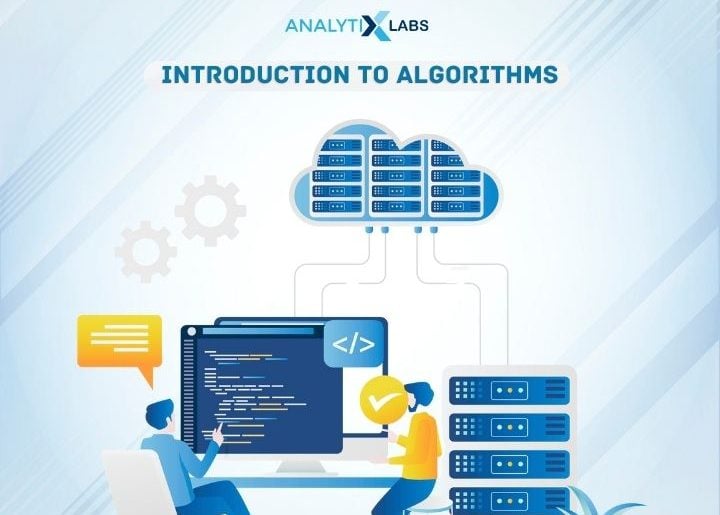


![Tree Traversal in Data Structure Using Python [with Codes] tree traversal in data structure](https://www.analytixlabs.co.in/blog/wp-content/uploads/2025/01/Cover-Image-1-370x245.jpg)



